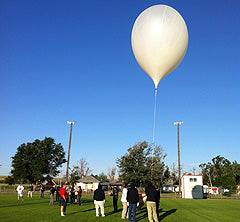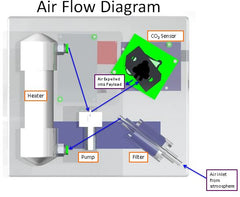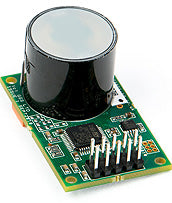
At CO2Meter, we get just as excited about science fair projects as the students. we also get a vast amount of inquiries when it comes to science projects and research.
So, it comes as no surprise when we heard from a 14-year old student named Matthew Siracusa and his inquiry on an upcoming project titled, "A Method for the Mobile Study of Fracking Sites.”
Matthew was looking for a way to monitor the air around shale oil hydraulic fracturing (fracking) sites from a moving vehicle. About 50% of these sites in the US are currently being monitored. His project was to create a platform using gas sensing technology that would reduce the cost of public monitoring of all the sites.
However, I was pleasantly surprised when Matthew informed us that his project had been entered into the Google Science Fair. After winning a Google local award and becoming a regional finalist, he has now gone on to compete with students internationally for a $25,000 scholarship and prizes from Google, the National Geographic Society and others to further their interest in science.
Matthew said, "For me, the project started out as a simple enough question: How do you inexpensively measure methane (CH4)? A typical non-dispersive infrared (NDIR) sensor to measure low concentrations (<1%) of CH4 are not only physically large, but are fairly expensive."
To stay within a budget, I had an alternative for him. Our lab testing had shown that NDIR CO2 sensors are cross-sensitive to other gases by varying degrees. For example, the COZIR CO2 Sensor is measurably cross-sensitive to methane (3.4 µm wavelength) and other gases at a similar wavelength to CO2 (4.25 µm).
When methane is present, the COZIR reports it as an increase in CO2. On the other hand, the SenseAir CO2 sensor has near zero cross-sensitivity to methane because of its narrow filtering around the 4.25 µm wavelength of CO2.

Therefore, in theory one could predict that the difference between the CO2 levels reported by the 2 sensors should be an accurate measure of CH4.
To test this, we started by zero referencing both sensors to nitrogen, then span calibrating them within the working range for reference. We found that using the COZIR and SenseAir sensors in combination solved both the CO2 and CH4 environmental measurement tasks simultaneously.
During the process, Matthew developed his own calibration techniques and learned gas law principles for compensation for pressure and temperature – things you don’t think about until you are attempting to measure with some precision. In the end, of course, CO2 and CH4 gas measurements were only one aspect of the project, yet we were fortunate to be able to work with Matthew and wish him the best in his future endeavors.
Designing Plant Growth Systems in Space
Someday we will travel to Mars. Once we get there, our survival will be in no small part because of the efforts of future engineers like Shyamal A. Patel who are working to design plant growth systems in space.

Shyamal (Sam) won the Best Individual Research Presentation for his project at the Undergraduate Research Discovery Day at Embry Riddle Aeronautical University, where he is currently a senior studying Aerospace Engineering. He has interned at Northrop Grumman, NASA, Boeing, Masten Space Systems, and Space Exploration Technologies (SpaceX). We were excited about Sam’s project using our CO2 and oxygen sensors, and asked him if he would tell us about it:
CO2Meter: What is your project called? What were your goals?
Sam: It’s called Project XGEN: Aeroponic Experiment Using Microcontroller Administered Nutrients and Lighting. The goal was to design and fabricate an aeroponic bioregeneration system and collect data on oxygen production, carbon dioxide reduction, and food production. Along with this, the system should be automated with little interference by the researcher.
CO2Meter: What are the benefits of this kind of research?

Sam: For a long duration mission, for example going to Mars, new breakthroughs must be achieved in life support systems, primarily environmental control. Oxygen production and carbon dioxide reduction is a crucial step in creating a livable atmosphere. On Earth, terrestrial plants and algae control the environment. The same can be done in space. This experiment is meant to collect data for future long duration space exploration missions and to create a mathematical model for planning such missions.
CO2Meter: What results did you achieve?
Sam: So far, project XGEN is capable of growing a strawberry plant in aeroponic conditions. The automated systems are still being programmed, and empirical data is being compiled by the control mechanism to create proper automated functions. Not only is the plant surviving, but flowers and strawberries are now growing.
CO2Meter: What got you interested in this project?

Sam: I have always been interested in farming primarily because of my grandfather. However, while becoming an aerospace engineer, farming and space exploration never linked until I learned about aeroponics.
CO2Meter: How were our sensors used in the experiment?
Sam: Both the K30 CO2 Sensor and the TR250Z Oxygen sensors were used. Many other sensors were used but the main data for research comes from the oxygen and carbon dioxide sensors. The goal is to collect data on oxygen production and carbon dioxide reduction from the plant growing inside of the chamber.
CO2Meter: What are your future plans?
Sam: I plan to work for SpaceX as an engineer after I graduate. I would like to incorporate the knowledge I am learning with this project for life support systems in space capsules and long duration space exploration missions.
Growing Plants in a Hostile Environment like Mars

Here at CO2Meter, we are always interested in helping young people interested in science. That’s why we were happy to help Tyler, a 7th grader, on his project at the Los Angeles Advanced Science Academy Science Fair.
For the experiment, he created 3 sealed terrariums, filed them with simulated Martian soil, and put a different plant in each. Using our CO2 Mini Air Quality Monitor, Tyler then measured the CO2 levels inside each of the terrariums over 30 days. Here’s what he discovered:
- Some varieties of plants do better in Martian soil than others.
- The plants that do well slowly lowered the CO2 levels in the enclosed terrariums.
- The plants that don’t do well raise the CO2 levels as they decomposed.
Tyler wrote: “I wanted to do this experiment because it seemed fun at the time, but also because I was genuinely curious about the results, and how much the plants would change the atmosphere in the terrariums. I have always had a major interest in space, and now it is stronger than ever, as I have done an experiment that may help us colonize our closest planetary neighbor, Mars. At least I hope it does!”
For his effort, Tyler was awarded 2nd place in his class, and was invited to exhibit his project at the Los Angeles County Science Fair.
Student Project Measures CO2 18 Miles Above the Earth

Students at Colorado State University designed an experiment to measure changes in carbon dioxide levels at different altitudes using a CO2 sensor carried by a weather balloon. The results of their experiment will be published through the Colorado Space Grant Consortium.
According to the student project representative Jeff Gier, the team launched the balloon and payload from Deer Trail, Colorado on August 2nd. The balloon traveled to about 96,000 vertical feet (29,260 meters) before bursting and falling back to the earth.
In order to obtain the most accurate CO2 level readings, the incoming air was conditioned by the use of a heating chamber and moisture filter. A micro pump forced the conditioned air across a K-30 CO2 sensor fitted with a sampling cap at a consistent flow rate, then expelled back into the atmosphere.
Click "Air Flow Diagram" on right to see details.
“During our flight, the sensor worked as expected, but a payload malfunction inhibited our ability to take correct readings on the ascent,” said Gier. The team did not realize that the heater needed to be warmed up for 15 minutes before use.
“Because of our lack of experience with the balloon launch schedule only about 4 minutes of warm-up time took place. This caused our readings to increase to nearly 500 ppm,” he added.
Fortunately, by the time the payload reached maximum altitude, the heater was fully warmed, and on the descent the readings were correct.
Jeff noted that the carbon dioxide level readings only went up to 42,000 feet. Beyond that height, the readings were too close to zero due to low atmospheric pressure. He believes that in the future a pressurized sensing chamber could allow readings to be taken up to a much higher altitude.
Since 1989, over 5,000 students have been directly involved in the Colorado Space Grant Consortium’s hands-on space hardware programs. Working with NASA, they have launched three rockets, three Space Shuttle payloads, two orbiting satellites (3CornerSat & Hermes), 10 sounding rocket payloads, 3 long-duration high altitude balloon payloads, and over 300 short-duration high altitude balloon payloads. In addition, students work on autonomous robotics projects and engage in telescope observing research and other faculty-led, space-focused research projects.
CO2 Sensors in International Space Station
Helping students learn about science through the use of our products is one of the privileges we have here at CO2Meter, so we were excited to learn that one of our COZIR wide-range CO2 sensors is slated to be used in a student experiment to go the International Space Station in March, 2016.
The experiment is part of the International Space Station (ISS) Project, a joint program between NASA and students. This experiment was designed by students from the Valley Christian High School in San Jose, CA.
The ISS Project's educational program provides students with the opportunity to conceive, design, build, test, integrate, and qualify computer-controlled science experiments that are then sent into space. Each experiment’s module data is downloaded to an ISS astronaut’s laptop and sent to Earth for evaluation by the students.
James Nadir, a Silicon Valley engineer who retired from Intel, mentors students in the Valley Christian High School ISS program. He reached out to CO2Meter for technical details. James wrote,
“The experiment measures the CO2 produced through the fermentation of Kampuchea Tea. The objective is to measure the relative amount of CO2 rather than the absolute (the station has a high CO2 content). The computer is made by Parallax and is called the Stamp. It is actually a system on a chip which integrates a PIC processor with PROM and RAM. The programming language is PBASIC. The Tokenizer occupies all of the on chip PROM, program and photo storage are in external components. The underlying flight program is a template driven custom BIOS system developed by school staff and myself. The resources available include I2C (SDA, SCL), 4 analog inputs (low input impedance 10bit ADC), and 8 digital IOs.”

Since 2011, The ISS Partner Program has successfully trained thousands of students from both public and private schools from the United States and abroad. Projects include 3D printing in space, crystallizing protein in micro-gravity, and many more.
How do you measure CO2 in an experiment?
For those also looking to create similar experiments gas sensors can be a valuable tool for accurate gas analysis. For measuring carbon dioxide, an NDIR CO2 Sensor is most commonly used.
What experiments can you do with carbon dioxide?
There are many additional simple and cost-effective science experiments that can be used to teach principles of chemistry, physics, and environmental monitoring.
Below, we have highlighted a few specific projects that can be done with our favorite gas, carbon dioxide.
- Inflating Balloons - using CO2 to show a chemical reaction between vinegar and baking soda.
- Carbon Dioxide and Respiration - using CO2 gas as an experiment with red cabbage juice as a pH indicator.
- Soda Explosion - using CO2 to show a reaction with diet soda and Mentos candy.
- Monitoring Air Quality - using CO2 sensors and our own exhaled breath to analyze the change in CO2 levels in a indoor air environment.
- Investigating Cellular Respiration - using invertebrates, germinating seeds, or other small organisms to collect respiration data and analyze environmental factors.
For more information on carbon dioxide sensor technologies or to further understand how to incorporate CO2 in your next project contact us today.


